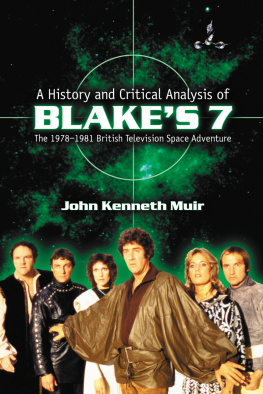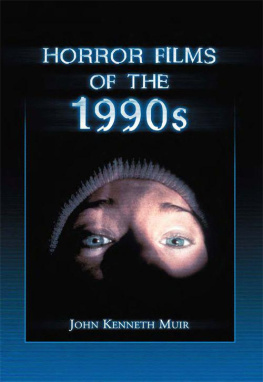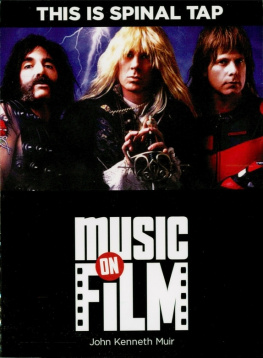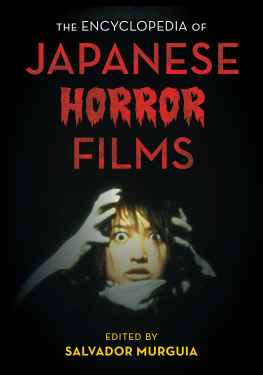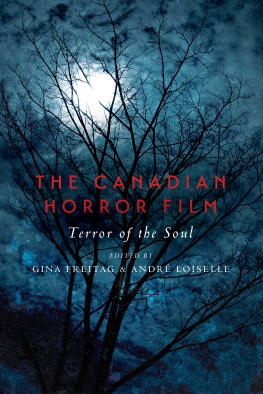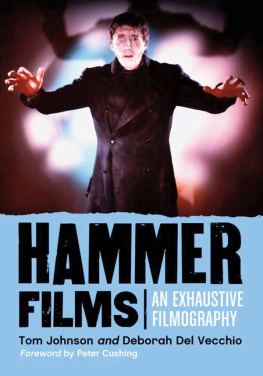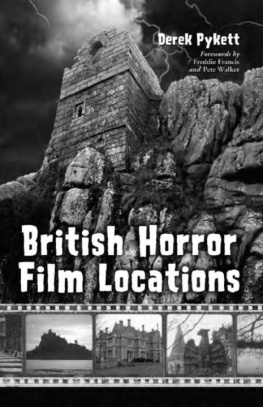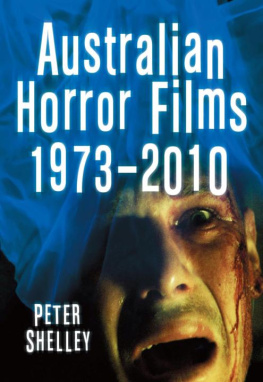Table of Contents
HORROR FILMS
OF THE 1970S
ALSO BY JOHN KENNETH MUIR
AND FROM MCFARLAND
____________________
Horror Films of the 1990s (2011)
Horror Films of the 1980s (2007)
The Encyclopedia of Superheroes
on Film and Television (2004)
Eaten Alive at a Chainsaw Massacre:
The Films of Tobe Hooper (2002)
An Analytical Guide to Televisions
One Step Beyond , 19591961
(2001; softcover 2006)
Terror Television: American Series,
19701999 (2001)
The Films of John Carpenter
(2000; softcover 2005)
A History and Critical Analysis of Blakes 7 ,
the 19781981 British Television Space Adventure (2000; softcover 2006)
An Analytical Guide to Televisions
Battlestar Galactica (1999; softcover 2005)
A Critical History of Doctor Who
on Television (1999)
Wes Craven: The Art of Horror
(1998; softcover 2004)
Exploring Space: 1999 : An Episode Guide and Complete History of the Mid-1970s Science Fiction Television Series (1997; softcover 2005)
HORROR FILMS
OF THE 1970S
John Kenneth Muir
____________________
McFarland & Company, Inc., Publishers
Jefferson, North Carolina, and London
LIBRARY OF CONGRESS CATALOGUING-IN-PUBLICATION DATA
Muir, John Kenneth, 1969
Horror films of the 1970s / John Kenneth Muir.
p. cm.
Includes bibliographical references and index.
ISBN-13: 978-0-7864-3104-5
1. Horror filmsUnited States
History and criticism.
I. Title.
PN1995.9.H6M85 2008
791.43'614dc21 2002006759
British Library cataloguing data are available
2002 John Kenneth Muir. All rights reserved
No part of this book may be reproduced or transmitted in any form or by any means, electronic or mechanical, including photocopying or recording, or by any information storage and retrieval system, without permission in writing from the publisher.
On the cover: Its Alive (1973)
McFarland & Company, Inc., Publishers
Box 611, Jefferson, North Carolina 28640
www.mcfarlandpub.com
For Ken and Loretta,
who took me to the drive-in to see Boggy Creek
and have encouraged me always.
Acknowledgments
This author wishes to thank the following people for their assistance and support in the shaping and development of this text: Kathryn Muir, Bill Latham, Johnny Byrne, Teddy Tenenbaum, Steve Hockensmith, Mateo Latosa, Robert, Tom, and Greg. Thanks, folks!
Introduction
Weve all heard the axiom that art imitates life, and most of us have a pretty good idea what it signifies. Art does not exist in a vacuum. Instead, it is inexorably bound to the time period from which it sprang. Sometimes an insight into a social or historical context in a work of art is entirely coincidental, arising from a set of understandings unknown even to the artist who rendered it. But more often than not there is intent in art to reflect, compare, reveal, contrast or echo some important element of the creators universe.
Another truism, one hoisted from the darker side of the aesthetic shelf, might offer an ancillary proclamation. Specifically, horror films have always mirrored the fears and anxieties of their real life epochs.
In the 1930s, protean genre films such as Dracula (1931) and King Kong (1933) represented a form of escapism for adventure-hungry and romance-starved audiences seeking to forget the daily drags and vicissitudes of the Great Depression. Likewise, 1950s era horror gems such as Them! (1955), which concerned radiation-spawned giant ants, played on the not-so-hidden fears of the American audience that its own government had opened up a deadly Pandoras box by splitting the atom. In the same era, Invasion of the Body Snatchers (1956) was viewed by many prominent critics as a thinly veiled indictment of Communism, a particularly timely target considering the pitch of the Cold War with Americas competitor, the Soviet Union, and the rampant paranoia of the McCarthy age.
Not surprisingly, the same paradigm proves true for yet another decade of the turbulent twentieth century: the freewheeling 1970s. The myriad horror films of the disco era likewise represent a catalog of that times mortal dreads and anxieties. Perhaps the only real significant difference between the 1930s or 1950s and the 1970s, however, is the sheer number of fears and apprehensions being evinced by the horror films of the period. Bluntly expressed, there was a lot more to be afraid about in the seventies.
Consider that the decade found people, and especially Americans, anxious about virtually every aspect of contemporary life. What was to be a womans role in American society during the post-hippie, womens lib, bicentennial world ? The Stepford Wives (1975) offered one nightmarish answer. What was to be the up-shot of all the random violence in the streets, and the worst crime rates in recorded American history? Stanley Kubricks A Clockwork Orange (1971) had a few thoughts about that subject. Could the average citizens inadvertent exposure to microwave ovens, industrial pollution, X-rays, a weakening ozone layer, or contaminated water alter the fundamental shape and evolution of human life? Larry Cohens Its Alive (1973) explored that frightening notion.
Similarly, Robert Wises The Andromeda Strain (1971) and Michael Crichtons Westworld (1972) fretted that mans escalating reliance on machines might prove his undoing. At the same time, Frogs (1972), Night of the Lepus (1972), Squirm (1976), Day of the Animals (1977), Kingdom of the Spiders (1977), Empire of the Ants (1977), The Swarm (1978), Prophecy (1979) and other 70s horror films about rampaging animals traded on different fears. Beneath the hokey special effects, these films reflected genuine audience trepidation that Mother Nature would not stand for mans continued pillaging and pollution of the Earth. These eco-horrors envisioned environmental apocalypse caused by humankinds own shortsightedness.
Even the innocence of the old King Kong was flipped on its head in the mid1970s. The big-budget (and much loathed) 1976 remake of the 1930s classic found an American oil corporation (a surrogate for Exxon) exploiting Kong, like some natural resource, on a mission not of unbridled adventure and awesome exploration, but of imperialism and cynicism. Kongs new bride in the 1970s version was no innocent, either, but a struggling, opportunistic actress looking to find her fifteen minutes of fame.
And it didnt stop there.
The Watergate scandal and President Nixons impeachment erupted in the early 1970s, and so the long-standing American pillar of trust in government soon crumbled to dust too. Consequently, horror films began to posit evil conspiracies at all levels of governmental bureaucracy. The town elders of Amity kept the beaches open in Jaws (1975) even though they knew a killer shark was prowling the waters off their coast. The doctors and politicos of Coma (1978) were responsible for a vast conspiracy exploiting the weak and rewarding only the rich and powerful. The presidential candidate of The Clonus Horror (1979) utilized living human clones as a bank of replacement body parts, and organized a cover-up to keep it under wraps all the while playing the public role of populist. Ron Rosenbaum succinctly described the national mood in Harpers Magazine in September of 1979:
Horror is here with us again. Even the White House has been haunted, as witness the rhetoric of Watergate; Alexander Haigs sinister outside force, John Mitchells White House horrors, Howard Hunts night-stalking spooks, a secret list of illegal campaign contributions maintained by the Presidents secretary and known as Rosemarys Baby; a cover-up, of course, is a premature burial, impeachment an exorcism.


